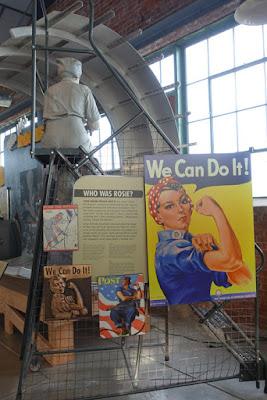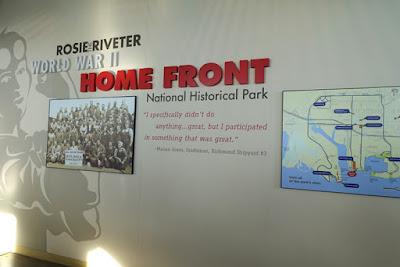Rosie the Riveter/WW II Home Front National Historical Park Visitor Center, Richmond, CA
During World War II, shipyards, factories, military bases, and businesses of all kinds around San Francisco Bay hummed with activity. At the
Rosie the Riveter/WW II Home Front National Historical Park in San Francisco’s East Bay one can explore how American civilians, especially women, lived, worked and contributed to the war effort at home.
"I specifically didn't do anything...great, but I participated in something that was great."
I visited the museum with my family in 2018 when they were visiting us in Oakland for the holidays. I had passed the sign for the turnoff to the park many times before as I sped on the 580 Freeway from Oakland to the Richmond/San Rafael Bridge on my way to Marin County. This time we took the exit. The park is at the edge of the Bay, looking onto a distant view of Angel Island and the city of San Francisco.
The Visitor Center is in the restored Ford Building, an assembly plant for jeeps and other military vehicles during the war--the largest assembly plant on the West Coast. Now, as a museum, it is filled with exhibits about the history of Richmond's wartime industries and workers.
As we walked through the museum, it felt like a trip back in time. Life-size dioramas dramatize daily life for the thousands of workers who worked at various wartime industries, many living in crowded rooms due to the housing shortage.
Many workers were women, who took over jobs previously done by men. These were the “Rosie the Riveters.”
Who Was Rosie?
Even during World War II, the term “Rosie the Riveter” served as shorthand for the women workers flooding the industrial workplace. The first Rosie popped up in a popular tune released in early 1943. As the song put it, “She’s a part of the assembly line. / she’s making history, ‘ Working for victory, / Rosie the Riveter.”
Artist Norman Rockwell was undoubtedly aware of the song when he painted the May 29, 1943, cover of the Saturday Evening Post. His subject is a young riveter on break, with her lunchbox clearly marked “Rosie.” The one-two punch of the song and magazine cover made Rosie a lasting icon.Child day care centers, funded by the government, solved the problem of the “eight-hour orphans”-- the children of working mothers. At home, people were encouraged to plant “Victory Gardens” as a way of contributing to the war effort by growing their own food.
Displays also told the darker stories of Japanese families forced to leave their homes to go to internment camps.
View of Angel Island and San Francisco from the front of the museum.
We watched a short film and listened to a talk by a very knowledgeable docent. We didn’t have time to fully appreciate all of the exhibits. We'll have to go back another day. As we returned to our car in the parking lot we passed the Rosie the Riveter monument in the center of the large park. The park is a popular spot for bikers and walkers. Next time we visit, we’ll allow more time to enjoy the fresh air and spectacular view across the bay.
This article was first published 10/8/18.
All text and photographs copyright Caroline Arnold.









